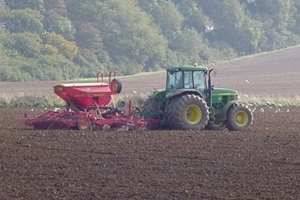By Joe Stanley, Head of Training & Partnerships, The Allerton Project
 There were some welcome announcements in Farming Minister Mark Spencer’s speech to the Oxford Farming Conference on 5 January, primarily in Defra’s acknowledgement that many of the costs associated with Countryside Stewardship have increased dramatically in recent years, with on-farm input cost inflation running at around 30% on average over the last 12 months.
There were some welcome announcements in Farming Minister Mark Spencer’s speech to the Oxford Farming Conference on 5 January, primarily in Defra’s acknowledgement that many of the costs associated with Countryside Stewardship have increased dramatically in recent years, with on-farm input cost inflation running at around 30% on average over the last 12 months.
New revenue rates are to be introduced for all new and existing Mid-Tier and Higher-Tier agreements from 1 January 2023, to reflect an average 10% uptick in scheme value. This will be welcome news to the c.30,000 Countryside Stewardship scheme holders across England. It’s also promising to note that there has been a 94% increase in scheme uptake in the last three years, as farmers increasingly look to adopt nature-friendly farming practices and introduce a valuable diversified income stream to their farm businesses.
Of particular note is the significant increase in payment rates for hedge-related work. We have long advocated for the huge natural capital value provided by both established and new hedgerows, and have buttressed the long-acknowledged biodiversity value by developing a Hedgerow Carbon Code, which will become available in 2023 to enable farmers and land managers to add a potentially valuable new revenue stream to their whole-farm accounts.
The uplift from £11.60 to £22.97/m for establishing new hedges (BN11) is particularly welcome, as is the uplift for gapping up (BN7) from £9.50 to £17.22. Laying (BN5) and coppicing (BN6) see more modest, but still welcome increases in value of £9.40 to £13.52 and £4 to £5.33 respectively: effective hedgerow maintenance is a vital part of ensuring the long-term health, utility and value of these living structures.
It’s also positive to see reasonable increases in value for common and hugely beneficial options such as winter bird feed (AB9) from £640/ha to £732/ha, and flower-rich margins and plots (AB8) from £628/ha to £673/ha. This will hopefully make these more complex but effective options increasingly popular in new applications going forward.
However, it remains incredibly frustrating that – three years into the Agricultural Transition Period – farmers were once again left with only promises for future clarity on the new Environmental Land Management Scheme (ELM). With many farms facing a 50% reduction in BPS payments in 2023, it seems incredible that the industry is still very much in the dark as to the makeup of the two main tiers of ELM, with a mere three Sustainable Farming Incentive standards currently available, and the recent announcement that the long-trailed Local Nature Recovery tier was being abandoned in favour of Countryside Stewardship Plus.
The headline announcement – that each SFI application would now receive up to an additional £1,000 to cover administration costs – does nothing to address a widespread concern that the budget set aside for ELM is completely insufficient to the scale of both government and the industry’s environmental and climate ambitions, alongside the imperative to sustainably feed a growing population. While we welcome the aspiration for ELM to be more flexible and farm ‘visits’ to be less like the inspections of old, it’s essential that the scheme itself is fit for purpose and delivers the outcomes we need to see.
The minister was correct when he noted that there need be no tension between environmental stewardship and food production: the experience of the Allerton Project over 30 years is proof of that, as we demonstrated when he visited us soon after being appointed to Defra last year. But it’s vital that a true value is placed on the natural capital services that farmers can uniquely provide within society, and that clarity – long overdue – is provided so that farmers can plan and budget in what is a time of unprecedented uncertainty and volatility.